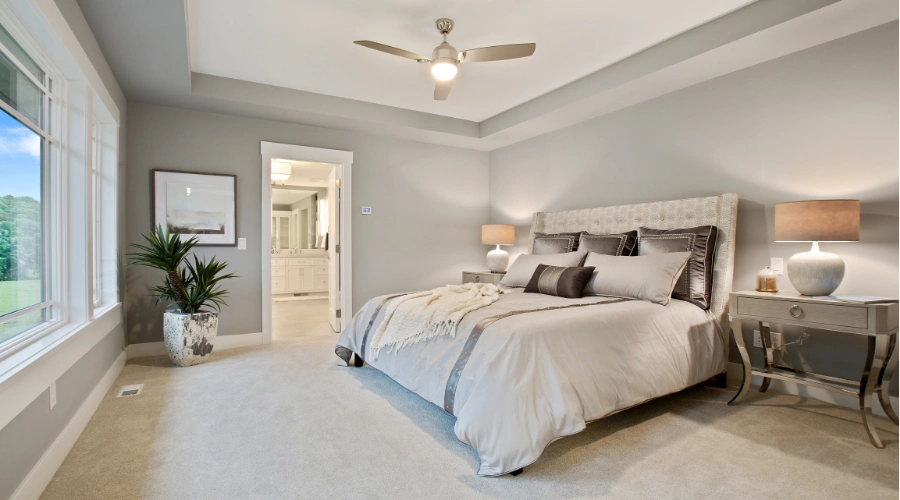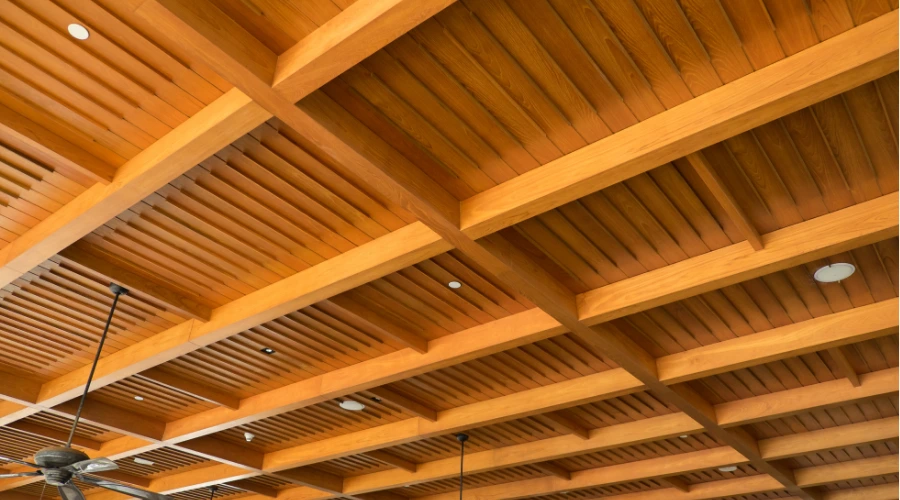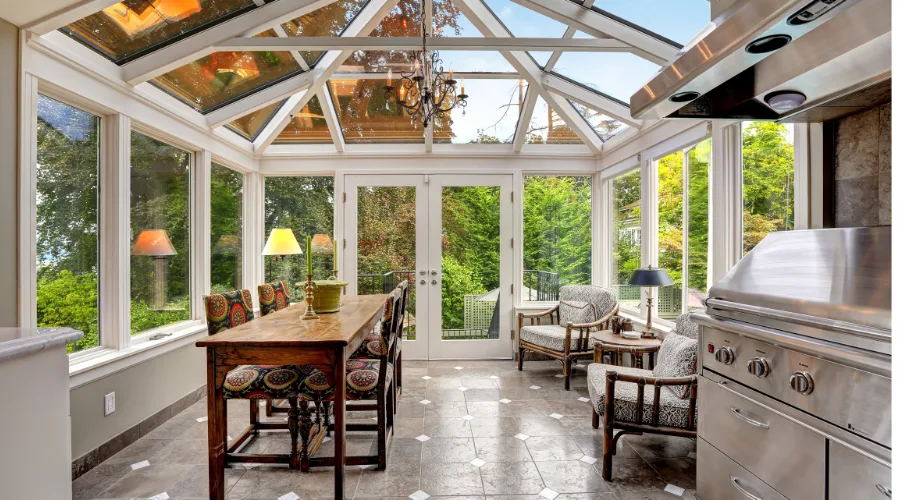Ceilings are the most overlooked part of any home, yet they influence the appearance and functionality of the space. They create a cohesive and inviting atmosphere, which can influence the size, acoustics, lighting, and style of the building. It is necessary to choose the right ceiling type based on the design needs and to achieve maximum benefits from it. This blog will explore different ceiling types in detail and could help you find out which ceiling best fits your housing needs.
Types of Ceilings
Conventional Ceiling
A conventional ceiling is the most basic and common type of ceiling that is typically flat, with no decorative details or complex designs. They are typically eight to nine feet high and are typically made of drywall or plaster. This ceiling type can be easily painted and textured to match various design options. It is easy to install and maintain, making it a standard and cost-effective ceiling option for most houses.
Key Features:
- It is a simple and clean ceiling type that offers a clean and uncluttered look.
- It is easy to clean and repair, reducing the time and effort spent on maintenance.
- It can be matched with different design options, making it suitable for versatile applications.
Tray Ceiling

A tray ceiling is a type of ceiling where the central portion is recessed compared to the outer edges, forming a boxy and tray-like shape. It creates a sense of depth and visual interest, making the space look more spacious. It can be matched with various design styles from traditional to modern looks.
Key Features:
- It adds a luxury touch and can increase the value of your property.
- The recessed areas can be used to hide wires, ductwork and other mechanical elements.
- It offers enhanced sound protection and gives a spacious feel.
- The cost of installation and maintenance is high, especially in recessed areas.
- It requires adequate ceiling height to avoid making the room feel more congested.
Coffered Ceiling

A coffered ceiling features a series of sunken panels, often in the shape of a square or rectangle. The sunken panels of the grid create visually interesting patterns and are typically framed by beams or mouldings. It can be combined with various designs from traditional to modern. It adds a sense of elegance and sophistication to the living spaces.
Key Features:
- It creates a striking visual impact, with a touch of luxury and comfort.
- It helps in reducing the noise levels and improving the sound quality.
- It adds more depth and enhances the perceived value of the home.
Vaulted Ceiling

A vaulted ceiling features a high-upward slope or arch, creating a sense of openness and height. The arch that sloped upwards meets at the peak or ridge, giving a spacious and grand look. It allows abundant natural light to the interior surface and adds more dramatic and unique architectural elements.
Key Features:
- It creates a dramatic and more visually pleasing effect.
- It adds a more distinctive and memorable element to a home.
- It is more expensive compared to a standard flat ceiling.
- It requires sufficient roof height to accommodate the slope and is difficult for existing buildings.
Cathedral Ceiling
A Cathedral ceiling is a type of vaulted ceiling that extends upwards to the roofline, creating a dramatic sense of height and openness. It helps make a room feel much larger than the actual size. This type of ceiling looks much like a Double Height Ceiling type. It allows abundant natural light into the space and creates a welcoming atmosphere. When associated with architectural elements, it adds a sense of elegance and sophistication.
Key Features:
- It gives a feeling of a spacious and more open area, even for smaller homes.
- The abundant natural light saves costs on artificial lighting.
- It is more expensive compared to standard ceilings, both in terms of construction and maintenance.
Beamed Ceiling
A beamed ceiling features exposed wooden beams across the ceiling surface, creating a rustic and industrial appeal. It is versatile and can be incorporated into various design styles from traditional to modern buildings. The beamed surface adds more depth, warmth, and a natural look to the room.
Key Features:
- It creates unique and visually interesting architectural features in the home.
- It helps absorb sound and improves the acoustics of the room.
- It adds property value to the home.
- It can be highly expensive, due to the usage of wooden beams.
- It requires adequate height for beam installation; otherwise it will reduce headroom.
- Placing lights may be difficult, as it could create a shadow effect.
- It requires periodic cleansing and maintenance, especially for the wooden beams to preserve their look.
False or Suspended Ceiling
It is the secondary ceiling constructed below the main ceiling of the building. The suspended structure uses formwork to support the ceiling and is made of various materials, including gypsum board, metal panels, and wood. It improves the acoustics of the room and facilitates the installation of other accessories behind the false ceiling.
Key Features:
- It enhances the overall appearance of the room with versatile designs and finishes.
- It reduces the noise transmission and maintains a quieter environment.
- It hides unsightly wires, pipes, and ductwork.
- The cost of installation is high compared to standard ceilings.
- It lowers the overall height of the living space.
- It requires regular cleaning and maintenance to ensure proper functioning.
How To Choose the Right Ceiling Type?
The choice of ceiling depends on various factors, including the room size, style, functionality, budget, and maintenance. By balancing all these factors, the right ceiling type can be determined.
Room Size
For smaller rooms, a conventional ceiling or tray ceiling can be ideal, as it can help make the room more open without congesting the limited space. On the other hand, vaulted, cathedral, or beamed ceilings can be ideal for large rooms, to fill the vertical space and give a grand and airy feel to the space.
Room Style
Coffered or beamed ceilings can be used to create traditional and elegant interiors, as they offer details and architectural interest. In the same way, conventional or tray ceilings can be the best fit for creating a modern and minimalistic design with sleek and clean lines. Beamed or coffered ceilings made of natural wood can be used to create a more rustic and industrial look for the living space.
Budget
Conventional ceilings are the affordable option when it comes to installation and maintenance. Whereas coffered, vaulted, and cathedral ceilings are more expensive and are suitable for high-end projects.
Maintenance
Conventional and tray ceilings are easy to clean and maintain. Whereas, beamed and coffered ceilings require high maintenance due to the regular treatment of wood and prevention of dust build-up.
Conclusion
In summary, choosing the right ceiling type impacts the look, feel, and functionality of the space. Coffered or beamed ceilings give the classical and rustic looks. Cathedral and vaulted ceilings offer more spacious looks, and false ceilings help hide the wires and absorb sound. Each ceiling type has its benefits, and the choice of ceiling is based on the housing needs.

